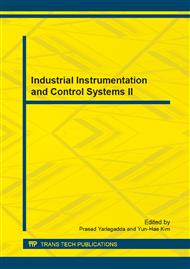[1]
R.Jiang, Q.S.Wu and Z.J Zhu, Full velocity difference model for a car-following theory, Phys. Rev. E vol.64(2001) 017101
DOI: 10.1103/physreve.64.017101
Google Scholar
[2]
T. Tang, H. Huang and H. Shang, Effects of the number of on-ramp on the ring traffic flow, Chin. Phys. B vol.19(2010)050517.
Google Scholar
[3]
Y. Natio, T. Nagatani, Safety-collision transition induced by lane changing in traffic flow, Phys. Let. A vol.375(2011)1319-1322.
DOI: 10.1016/j.physleta.2011.02.002
Google Scholar
[4]
X. Zhao and Z. Gao, A new car-following model:full velocity and acceleration difference model, Euro.Phys. J. B vol.47(2005) 145-150.
DOI: 10.1140/epjb/e2005-00304-3
Google Scholar
[5]
J F Tian, B Jia, X Li and Z.Gao, A new car-following model considering velocity anticipation, Chin. Phys. B vol.19(2010) 010511.
Google Scholar
[6]
T. Nagatani, The physics of traffic jams, Rep. Prog. Phys,vol.65 (2002) 1331-1368.
Google Scholar
[7]
R. Nagai, T. Nagatani, A. Yamada, Phase diagram in multi-phase traffic model, Phys. A vol.355(2005 )Phys. A 530-550.
DOI: 10.1016/j.physa.2005.04.004
Google Scholar
[8]
M. Bando, H. Hasebe, A.Nakayama, A. Shibata and Y. Sugiyama, Dynamical model of traffic congestion and numerical simulation, Phys. Rev. E vol.51(1995) 1035-1042.
DOI: 10.1103/physreve.51.1035
Google Scholar
[9]
Z. Li, F. Liu and J. Sun, A lattice traffic model with consideration of preceding mixture traffic information, Chin. Phys. B vol.20(2011) 088901.
DOI: 10.1088/1674-1056/20/8/088901
Google Scholar
[10]
T. Tang, C. Li and H. Huang, A new car-following model with the consideration of the driver's forecast effect, Phys. Let. A, vol.374(2010)3951-3956.
DOI: 10.1016/j.physleta.2010.07.062
Google Scholar
[11]
R.Jiang, Q.Wu and Z.Zhu, Full velocity difference model for a car-following theory, Phys. Rev. E vol.64(2001) 017101
DOI: 10.1103/physreve.64.017101
Google Scholar


